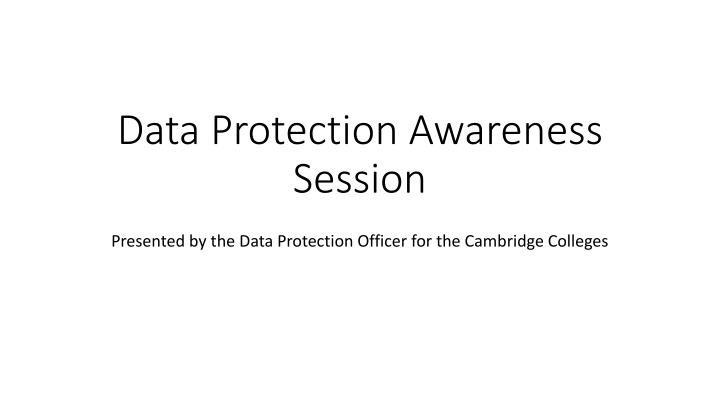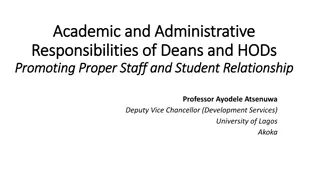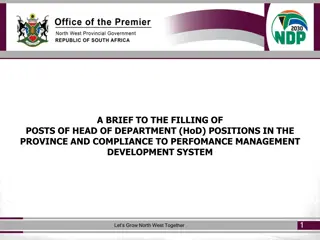
Data Protection Awareness at Cambridge Colleges: Legislation, Compliance, & Responsibilities
Dive into a comprehensive session on data protection awareness presented by the Data Protection Officer for the Cambridge Colleges. Explore current data protection legislation, GDPR guidelines, compliance responsibilities, and more to ensure data security. Understand the key concepts, regulations, and best practices to safeguard sensitive information effectively.
Download Presentation

Please find below an Image/Link to download the presentation.
The content on the website is provided AS IS for your information and personal use only. It may not be sold, licensed, or shared on other websites without obtaining consent from the author. If you encounter any issues during the download, it is possible that the publisher has removed the file from their server.
You are allowed to download the files provided on this website for personal or commercial use, subject to the condition that they are used lawfully. All files are the property of their respective owners.
The content on the website is provided AS IS for your information and personal use only. It may not be sold, licensed, or shared on other websites without obtaining consent from the author.
E N D
Presentation Transcript
Data Protection Awareness Session Presented by the Data Protection Officer for the Cambridge Colleges
We will look at We will look at Overview of data protection legislation Current data protection legislation A quick overview Who is responsible for compliance? Data breach What is it? How can we avoid it? Data protection impact assessment (DPIA) What is it? Do we need it?
Current Data Protection Legislation The General Data Protection Regulation (the GDPR) The UK General Data Protection Regulation (UK GDPR) The Frozen GDPR (As it stood on 31 December 2020) The European Union (Withdrawal) Act 2018, as amended by the Data Protection, Privacy and Electronic Communications (Amendments etc)(EU Exit) Regulations 2019 as amended by the Data Protection, Privacy and Electronic Communications (Amendments etc)(EU Exit) Regulations 2020 The Data Protection Act 2018 (DPA 2018)
A Quick Overview Personal data only includes information relating to natural persons who: - can be identified or who are identifiable, directly from the information in question; or - can be indirectly identified from that information in combination with other information. Storage limitation Integrity and confidentiality (security) Accountability e) Public task f) Legitimate interests Lawfulness, fairness and transparency Purpose limitation Data minimisation Accuracy b) Contract c) Legal obligation d) Vital interests 1.Right to be informed 2.Right of access 3.Right to rectification 4.Right to erasure 5.Right to restrict processing 6.Right to data portability 7.Right to object 8.Rights in relation to automated decision making and a) Consent Personal data and special category data Data controller and Data processor Data protection principles Lawful basis for processing Individual rights profiling. Special category data Racial or ethnic origin; Political opinions; Religious or philosophical beliefs; Trade union membership; genetic data; biometric data (where used for identification purposes); Data relating to Health; Sex life; and Sexual orientation. f) Legal claims or judicial acts g) Reasons of substantial public interest h) Health or social care i) Public health j) Archiving, research and statistics Special category data requires lawful basis AND one of 10 conditions for processing: a) Explicit consent b) Employment, social security and social protection c) Vital interests Controllers are the main decision-makers they exercise overall control over the purposes and means of the processing of personal data. Processors act on behalf of, and only on the instructions of, the relevant controller. d) Not-for-profit bodies e) Made public by the data subject
Who Is Responsible for Compliance? We are! Individually and collectively
Personal Data Breaches Personal Data Breaches ICO definition: A personal data breach is a breach of security leading to the accidental or unlawful destruction, loss, alteration, unauthorised disclosure of, or access to, personal data. Any incident involving personal data should be reported following the College s reporting procedures*, e.g. reporting to manager, filing an incident report online, emailing the College Data Protection Lead, etc. *Heads of Department should ensure this information is available to all their staff. The College Data Protection Lead and the Data Protection Officer will assess the level of risk the incident poses to people (i.e. likelihood and severity of the risk to people s rights and freedoms). Depending on the outcome, the College may report the breach to the ICO and/or data subjects affected.
Breakdown of Breach Types 2018 Breakdown of Breach Types 2018- -2020 2020
How Can We Avoid Data Breaches? How Can We Avoid Data Breaches? We Can t! but, we CAN work together and Ensure that our processes and procedures follow data protection Principles Monitor our adherence (i.e. compliance) in our own areas (documentation, retention, data sharing, etc.) Be vigilant about risks (real or potential) Identify, assess and manage risks (accept, eliminate, reduce, mitigate): data protection impact assessments? Engage with the Compliance Officer and College Data Protection Lead (Bursar)
Reducing the Risk of Email Breaches Reducing the Risk of Email Breaches (https://www.ois.cam.ac.uk/system/files/documents/email (https://www.ois.cam.ac.uk/system/files/documents/email- -communications communications- -good good- -practice practice- -note.pdf) note.pdf) Is email the best method? Consider distribution groups and keep them up-to-date Use of CC or BCC Consider encryption Access to shared mailboxes or shared role accounts Appropriate storage and retention Before you click on that link or attachment Just before pressing Send , check: Recipient(s) Address field Message contents (scroll down!) Attachments
Dealing with Email Breaches Dealing with Email Breaches Speed is of the essence! Attempt to recall the email as soon as the error has been discovered Notify the unintended recipient(s), asking them: i. to delete the original email without opening/reading (this is especially important in case the Recall function has not worked); ii. to confirm deletion to you (e.g. by responding to the notification email); iii. not to forward the original email to anyone else; iv. If the unintended recipient has forwarded the email to others, repeat the above steps with the additional recipients too If the email was sent to a group rather than an individual, follow the above steps for all recipients. In addition, ask them to delete any email chains that may have been created as a result of this error Send the email again as a New message, ensuring that all aspects of the communication are correct Report the incident to manager and follow College procedure
Hypothetical Scenario 1 Hypothetical Scenario 1 Part A Part A A member of College staff sends a generic email to all postgraduate offer-holders. The sender uses the To field instead of BCC . Individuals are based in 35 countries, inc. China, Russia and USA. Q: What would you think and do if you saw this? What happened: The staff member did not think this mattered because the students would get to know each other pretty soon. They did nothing. Q: Is this a breach? A: Yes.
Hypothetical Scenario 1 Hypothetical Scenario 1 Part B Part B One of the Offer Holders uses the addresses to circulate a survey for their PhD research. The College hears about this through a recipient. Q: What would you think and do if you saw this? What happened: The staff member thought this was not a big issue. Afterall, the sender would be doing their PhD in the College. However, because the recipient sounded concerned, the staff member told their line manager, who reported it to the College Data Protection Lead. Q: Is this a breach? A: Yes.
Hypothetical Scenario 1 Hypothetical Scenario 1 Part C Part C (will not appear in published version) (will not appear in published version) DPO assessment: The College did not attempt to recall the original email, nor alert the recipients of the importance of NOT using/sharing the data further; Neither departmental procedures nor College privacy notice referred to such use of their private email addresses. The individuals therefore would not have expected the College to share their personal email addresses in this way; Officially, the College only became aware of it after a recurrence; As no remedial measures had been implemented, the breach was ongoing and, given the length of time lapsed between the breach occurring and its discovery, remedial efforts were unlikely to contain it fully; Given the above, the risk of further recurrences was high, which also increased the likelihood of loss of trust in the College and complaints from data subjects; and Individuals were not made aware of potential risk of external elements using their addresses for malicious or criminal purposes.
Hypothetical Scenario 1 Hypothetical Scenario 1 Part D Part D (will not appear in published version) (will not appear in published version) DPO advice in these situations: 1. The Sender should send a new email to ALL recipients (using the bcc field) and: o Apologise for the earlier error; o Ask ALL recipients to delete that original email and any threads resulting from it; o Remind them that anyone using the contact details is effectively acting as a data controller, which constitutes a breach in its own right; and o Request that, going forward, any instances of someone using the original email as a means of communicating with others be reported to the College as soon as possible. 2. If the original email contained important information, the Sender should send it in a new email, ensuring that all addresses are in the bcc field. This is so that no one decides to keep the original email because of its content; 3. A senior staff member should also consider contacting the survey distributor separately, in addition to the above measures, to remind them of the importance of good email communication practices, especially considering they are about to embark on postgraduate studies. The DPO suggests, advises, monitors and recommends. The College Data Protection Lead makes the final decision on whether to accept or reject them, including where it relates to ICO notifications.
Hypothetical Scenario 2 Hypothetical Scenario 2 A member of the College catering staff notices that the board containing list of students allergy information is fully visible from the window near the dining hall entrance. Q: What would you think and do if you saw this? What happened: The staff member raised it with the Catering manager. They considered whether they needed this information on display. They did. The relocated the board to a wall not visible from outside. Reported it to DPO. Q: Is this a breach? A: No.
Data Protection Impact Assessment (DPIA) Data Protection Impact Assessment (DPIA) A data protection impact assessment (DPIA) is a process to help you identify and minimise the data protection risks of a specific type of data processing or project. Colleges should also consider undertaking a DPIA if they believe there might be a significant risk of harm to individuals. Ideally, before you embark on the process or implement the new system! DPIA Screening Questionnaire DPIA Form If unsure, please ask the Compliance Officer!
Automatic exclusion of a student from Cambridge Bursary Schemes list of eligible applicants if the Student Loans Company (SLC) rejects them Eligibility for hardship funds, grants in relation to a disability, etc. Room allocation based on students special needs (religious, medical etc.) Special pensions benefits for staff due to disability Occupational health management Adjustments for exams due to special needs (religious, medical etc.) Social-media networks Voluminous mailshot (marketing) Wealth screening of alumni Applying AI to an existing process Direct marketing Wealth screening of alumni Other assessments of how alumni can engage more closely with the College Student admissions decisions (combining UCAS data with direct application forms, pre-admissions tests, and College-generated interview scores) Students/staff with safeguarding issues Social care records Complaint procedures or disciplinary action, especially where one member of College makes an accusation against another member of College






















